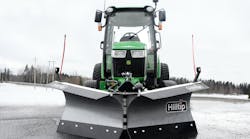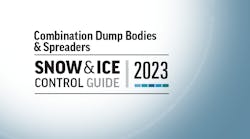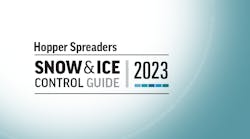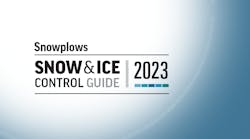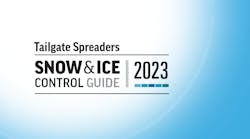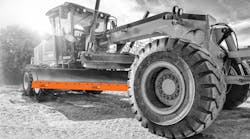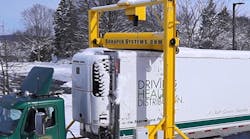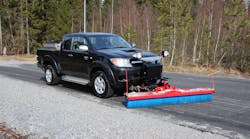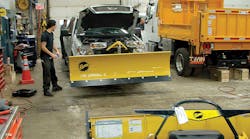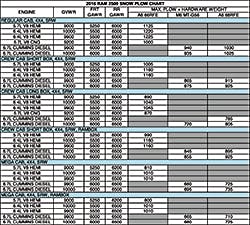The most significant changes in the manufacturers’ guidelines for snowplow mounting for the 2017 model year come from Ford.
Ford’s Ken Tyburski, supervisor of product information for special vehicle engineering, said capacity ratings have changed for the Super Duty F-250/350/450/550. Changes affect the regular cab, super cab, and crew cab with 6.7L diesel. Please consult the accompanying 2017 Ford charts.
Also for 2017 Super Duty, there are different (higher capacity) alternator standard offerings than 2016 MY. Minimum required equipment for the Snowplow Prep Package (473) includes:
• 6.2L gasoline: extra HD 200-amp alternator; optional 240-amp extra HD alternator.
• 6.7L diesel pickup: extra HD 220-amp alternator; optional 332-amp dual alternators.
• 6.7L diesel chassis cab: 332-amp dual HD alternators; optional 377-amp dual extra HD alternators.
For the F-150, the plow bracket, plow allowable weight capacity, and ballast information are a carryover from the 2016 MY.
Ken Joye, GM’s Upfitter Integration liaison engineer, said the 2500HD/3500HD diesel pickup and cab chassis cab models will receive a new appearance featuring a new hood with a functional hood scoop. The exterior refresh should have little to no effect on existing snowplow installation procedures. Front exterior update drawings will be available in the GM UI Online Body Builder Manual at the start of regular production, and 3D math data can also be requested at www.gmupfitter.com at that time. RPO VYU “Snowplow Prep Package” availability on Heavy Duty 4WD “K” Series model offerings remains unchanged.
According to gmupfitter.com, “some owners of snowplow-equipped Chevrolet Silverado/GMC Sierra models may experience any of the following: IPC cluster/radio/HVAC display blanks out, Bluetooth phone or Pandora connection dropped, the radio station or volume changes when operating the snow plow. If any of these symptoms are experienced, please refer to UI Bulletin #124 for detailed information.”
For the 2017 model year, the light-duty 1500 series pickup models remain unchanged (the 2016 front-frame changes are a carryover).
On the electrical side, some 2500HD/3500HD headlamps/connectors may be changing. For plow manufacturers with designs that interface with headlamp connectors, please contact www.gmupfitter.com for more information.
New for 2017, Chevrolet Silverado HD trucks feature a patented air intake system that drives cool, dry air into the engine for sustained performance and cooler engine temperatures during difficult driving conditions. The intake system underwent extensive testing based on the most challenging real-world driving conditions to ensure capable performance no matter the weather.
Some light-duty and heavy-duty pickups will experience a late model year introduction; 2017 HD models will not start production until late fall.
The 2017 “Snowplow Prep” charts and usage for Chevrolet and GMC light- and heavy-duty “K” Series trucks will be mostly a carryover. This section of the online “GM UI Body Builder Manual” will be updated closer to 2017 introduction. See the GM Upfitter Integration website “Special Applications”, “K-Series Snowplow Prep” section for all available information.
Chris Borczon, supervisor of the Ram commercial vehicle team, said this is a carryover year and there are no changes.
Ford Trucks
For F-150, the minimum required equipment is 4x4 only and the Snowplow Prep Package (68P):
• Requires 5.0L V8 engine (99F).
• Lariat trim (only) – Electronic Shift-On-The-Fly (ESOF) replaces standard 2-speed automatic 4WD.
• Lariat Technology Package (68T) not available with Snowplow Prep Package (68P).
• Available on Regular, SuperCab and SuperCrew models (5.5’, 6.5’ and 8.0’ boxes).
• Available with XL, XLT, and Lariat Trim.
• Both regular and heavy duty payload packages.
• “Snowplow” mode button on instrument panel will disable (load shed) the following features to maintain required electrical charge margins during plow operation/use: 110V inverter, fog lamps, heated steering wheel, heated front/rear seats, and massaging seats. Snowplow mode button also activates relay to snowplow controls.
NOTE: The engine Outside Air Temperature (OAT) sensor is subject to error unless relocated to unblocked airflow.
Completed vehicle weight:
• Recommended plow assembly and aft-of-rear axle ballast weight limits are shown in the attached chart. These snowplow weight limits are based upon a vehicle built with noted trim levels with no additional Ford option content, a total of 300 lbs for a driver plus one front seat passenger (150 lbs each), ballast weight rearward of the rear axle, and additional assumptions for commercially available snowplow assembly weights and mounting location.
• The vehicle must not be operated when overloaded. A vehicle is overloaded when the weight of the completed vehicle with aftermarket equipment installed, plus driver, passengers, and cargo, exceeds either the FGAWR, RGAWR, or GVWR established by Ford Motor Company and displayed on the Safety Compliance Certification Label.
• The addition of ballast weight placed rearward of the rear axle is required to prevent exceeding FGAWR, and to provide good vehicle braking and handling. The ballast should be attached securely to the vehicle with consideration for the normal driving dynamics of snowplowing, and occupant safety in accidents.
Total accessory reserve capacity:
• For Ford completed vehicles of 10,000 GVWR or less, the weight of permanently attached aftermarket equipment must not exceed the Total Accessory Reserve Capacity (TARC) displayed on the Safety Compliance Certification Label to maintain the compliance representation that came with the Ford-built vehicle. Exceeding TARC will require re-certification. This applies only to the permanently attached equipment, such as the snowplow frame mounting hardware, and not to the removable portion of the snowplow blade assembly.
Front-end wheel alignment and headlight aim:
• Front end wheel alignment (toe) and headlight aim may require readjustment after installation of snowplow equipment. Failure to reset front wheel alignment may cause premature uneven tire wear. If required, reset to chassis manufacturer’s specifications found in the Ford Shop Manual.
Electrical connections:
• Installation of any inductive load devices such as electric motors, or electric clutches for clutch pumps, must not be connected to Ford vehicle wiring or fuse panels. Power for such devices should be taken directly from the battery or starter motor relay power terminal. Control of these devices should be achieved via relays. No direct current path should exist between Ford vehicle wiring and the installed load that is not filtered by the battery. These recommendations are intended to eliminate or minimize any induced reverse voltage into the Ford circuitry.
• Vehicles equipped with the Snowplow Prep option will include the Snowplow Mode switch located on the dash. Activating Snowplow Mode will provide 10 Amp B+ power to a dedicated feed for the plow controller. It is a blunt cut Yellow/Orange wire, and is found taped to the headlamp switch harness, behind the left side of the driver’s side dash panel. When activated, the vehicle will enter a special load shedding strategy to ensure continuous operation of the plow during periods of high electrical demand.
For Super Duty F-250/350/450/550, the minimum required equipment is 4x4 (all pickups, F-350 chassis cab) and the Snowplow Prep Package (473), which includes:
• Front spring/GAWR upgrade (refer to the Weight Ratings charts for specific spring/GAWR selection for each model).
• 6.2L gasoline: Extra HD 200-amp alternator; optional 240-amp Extra HD alternator.
• 6.7L diesel Pickup: Extra HD 220-amp alternator; optional 332-amp dual alternators.
• 6.7L diesel chassis cab: 332-amp dual HD alternators; optional 377 amp dual extra HD alternators.
Plow and attaching hardware weight limits as tabled below.
Recommended equipment:
• All-terrain tires and roof clearance lights (optional with SRW Pickup models, required with F-350 DRW and F-450).
Standard equipment:
• Front and rear stabilizer bar (rear standard on Chassis Cab and DRW pickup models).
• Roof clearance lights (standard on Chassis Cab and required on Pickup models).
• Steering damper.
• Engine oil cooler, auxiliary automatic transmission oil cooler and maximum capacity engine coolant radiator are standard.
• All available axle ratios are acceptable.
• When snowplowing, operate automatic transmission with shift lever in Overdrive position.
Completed vehicle weight:
• Snowplow weights (maximum recommended): Refer to the tables below. The vehicle must not be operated when overloaded. A vehicle is over-loaded when the weight of the completed vehicle with aftermarket equipment installed, plus driver, passengers and cargo, exceeds either the FGAWR, RGAWR or GVWR displayed on the Safety Compliance Certification Label.
The addition of ballast weight placed rearward of the rear axle may be required to prevent exceeding the FGAWR, and provide good vehicle braking and handling. The ballast should be attached securely to the vehicle with consideration for the normal driving dynamics of snowplowing and occupant safety in accidents.
• For Ford completed vehicles of 10,000 lbs GVWR or less, the weight of permanently attached aftermarket equipment must not exceed the Total Accessory Reserve Capacity (TARC) displayed on the Safety Compliance Certification Label to maintain the compliance representation that came with the Ford built vehicle. Exceeding TARC may require re-certification. This applies only to the permanently attached equipment, such as the snowplow frame mounting hardware, and not to the removable portion of the snowplow blade assembly.
Front-end wheel alignment and headlight aim:
• Front-end wheel alignment (toe) and headlight aim may require readjustment after installation of snowplow equipment. Failure to reset front wheel alignment may cause premature uneven tire wear. If required, reset to chassis manufacturer’s specifications found in the Ford Shop Manual.
Electrical connections:
• Installation of any inductive load devices, such as electric motors or electric clutches for clutch pumps, must not be connected to Ford vehicle wiring or fuse panels. Power for such devices should be taken directly from the battery or starter motor relay power terminal. Control of these devices should be achieved via relays. No direct current path should exist between Ford vehicle wiring and the installed load that is not filtered by the battery. These recommendations are intended to eliminate or minimize any induced reverse voltage into the Ford circuitry.
Warranty:
• The Ford New Vehicle Limited Warranty applies to vehicles with snowplows installed in accordance with these guidelines. Consult your Ford dealer or the Owner’s Guide for any further questions.
General Motors
GM recommends that when a snowplow is mounted on a vehicle, only one passenger should accompany the driver. More than one passenger may exceed front Gross Axle Weight Ratings.
Prior to installing a front-mounted snowplow, the following process should be followed and necessary information obtained:
• Establish vehicle curb weight.
• Establish chassis manufacturer’s front and rear axle weight ratings.
• Chevrolet and GMC truck dealers can provide availability, specifications, GVWR, and Front and Rear GAWR. For vehicles already built, this information can be found on the certification label installed on the driver’s door/frame or provided on the cover of the Incomplete Vehicle Document.
The following information should be obtained and provided by the manufacturers of snowplows and salt spreaders:
• Specifications, weights, and center of gravity data.
• Vehicle installation guidelines and instructions.
• Calculation of weight distribution for the front and rear axles.
The loaded vehicle with driver, passenger, aftermarket accessories, snowplows, spreader, and cargo must not exceed the GVWR, and Front and Rear GAWR.
In addition, the completed curb weight vehicle, with all installed aftermarket accessories, snowplow, and spreader, and with 400 lbs distributed in the driver-passenger area of the vehicle, must have a center of gravity that is located within the trapezoid formed by the coordinates A, B, C, D, H1 and H2, plus it must be to the rear of vertical line E and forward of vertical line F as defined in the Allowable Center of Gravity charts. If the center of gravity does not fall within the specified trapezoid, ballast weight may be required to shift the center of gravity until it falls within the specified trapezoid.
The snowplow manufacturer and the installer of the aftermarket equipment should determine the amount of rear ballast required to ensure that the vehicle, with the attached snowplow and aftermarket equipment, complies with the Allowable Center of Gravity Trapezoid and the resulting front and rear weight distribution ratio as defined in the Allowable Center of Gravity Charts published in the GM manual.
The use of rear ballast weight may be required to prevent exceeding the GAWR of the front axle. The use of rear ballast weight may be required to ensure that the center of gravity location of the completed vehicle, with the attached snowplow and other installed equipment, complies with the Allowable Center of Gravity Trapezoid and the resulting front and rear weight distribution ratio, even though the actual front weight may be less than the GAWR of the front axle. In either case, the rear ballast weight should be securely attached in the cargo box or behind the rear axle of the vehicle in a manner that prevents it from moving during driving and stopping.
To help avoid personal injury, refer to Z-height setting procedure before adjusting torsion bars. If torsion bars are adjusted for aftermarket equipment, be sure to return them to specification when the equipment is removed. Otherwise, a front shock absorber may dislodge and damage a front brake line. This could result in an accident when minimum stopping distances are required.
Ram Trucks
The loaded vehicle, including all aftermarket accessories, the snowplow system, passengers, and cargo, must not exceed the gross vehicle weight (GVW), front or rear gross axle weight (GAW) ratings specified on the Safety Compliance Certification label located in the driver’s side door opening.
The empty truck with all permanently attached accessories and snowplow components must not exceed 62% of its total weight on the front axle to comply with FMVSS/CMVSR 105 Brake Certification. Permanently attached snowplow parts are those parts not easily removed when the blade is removed. The permanently attached parts are: subframe, hydraulic pump, hydraulic lift cylinder, lamps, wiring, snowplow controls, etc. If the front axle loading exceeds either 62% of the empty truck total weight, or the front GAWR, ballast compensating weight must be securely attached at the rear of the truck to bring front axle weight within weight specifications.
Notes for heavy-duty snowplows:
• At any time, the maximum number of occupants in the truck must not exceed two.
• Under any circumstances, vehicles should not exceed GVWR (Gross Vehicle Weight Rating), front or rear GAWRs (Gross Axle Weight Ratings).
• Snowplow prep packages are not available with Sport (AAG) package.
• Cargo capacity will be reduced by the addition of options.
• Ballast should be securely attached inside the box at 9” from the rear tailgate for pickups.
• The total weight of permanently attached hardware should not exceed 125 lbs.
• Max snowplow weight should not exceed values for models shown in this section.
